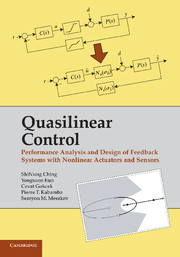 Quasilinear Control
Quasilinear Control Book contents
- Frontmatter
- Contents
- Preface
- 1 Introduction
- 2 Stochastic Linearization of LPNI Systems
- 3 Analysis of Reference Tracking in LPNI Systems
- 4 Analysis of Disturbance Rejection in LPNI Systems
- 5 Design of Reference Tracking Controllers for LPNI Systems
- 6 Design of Disturbance Rejection Controllers for LPNI Systems
- 7 Performance Recovery in LPNI Systems
- 8 Proofs
- Epilogue
- Abbreviations and Notations
- Index
Epilogue
Published online by Cambridge University Press: 01 June 2011
- Frontmatter
- Contents
- Preface
- 1 Introduction
- 2 Stochastic Linearization of LPNI Systems
- 3 Analysis of Reference Tracking in LPNI Systems
- 4 Analysis of Disturbance Rejection in LPNI Systems
- 5 Design of Reference Tracking Controllers for LPNI Systems
- 6 Design of Disturbance Rejection Controllers for LPNI Systems
- 7 Performance Recovery in LPNI Systems
- 8 Proofs
- Epilogue
- Abbreviations and Notations
- Index
Summary
This volume has extended major ideas and results of linear control theory to systems with nonlinear actuators and sensors. Namely, the linear frequency domain methods (based on the frequency of harmonic inputs) are extended to the quasilinear frequency domain (based on the bandwidth of random inputs). The linear time domain methods are extended to quasilinear ones by introducing tracking quality indicators (instead of overshoot and settling time) and by modifying the root locus technique (e.g., the saturated root locus). The LQR/LQG methodology has been extended to SLQR/SLQG (where the “S” stands for “saturated”). Although not included in this volume, the H∞ and LMI techniques have also been extended to systems with nonlinearities in sensors and actuators.
In addition, new problems, specific for LPNI systems, have been formulated and solved. These include Instrumented LQR/LQG, where the optimal controller and instrumentation are synthesized simultaneously, and the problem of performance recovery, where the performance losses due nonlinear instrumentation are either contained to a desired level or eliminated altogether.
What made these results possible?
The method of stochastic linearization provided a tool for reducing the nonlinear systems addressed in this volume to quasilinear ones.
The methods of linear control theory could be applied, with some modifications, to the quasilinear systems mentioned above.
The resulting relationships and techniques, as it turns out, are quite similar to those of linear control theory.
- Type
- Chapter
- Information
- Quasilinear ControlPerformance Analysis and Design of Feedback Systems with Nonlinear Sensors and Actuators, pp. 275 - 276Publisher: Cambridge University PressPrint publication year: 2010


